| C H A P T E R 2 |
|
Information About Hardware |
This section describes the special instructions and the issues about the SPARC Enterprise M8000/M9000 server hardware.
Sun Storage J4200 SAS JBOD arrays have six general-purpose SAS connectors. With FW version 3A32 or higher, each of them can be connected to separate SAS initiators, therefore up to six systems can be connected to the array. Each system can use a different disk on the array as its boot device. J4200 arrays have 12 disks, so each boot device can be mirrored for higher reliability. J4200 arrays can be configured into multiple zones to provide a more secure environment.
For related information, see Sun StorageTek Common Array Manager Software documentation, at:
http://docs.sun.com/app/docs/prod/stor.arrmgr#hic
The Solaris cfgadm(1M) command does not always unconfigure a DVD drive from a domain on SPARC Enterprise M8000/M9000 servers.
Disable the Volume Management Daemon (vold) before unconfiguring a DVD drive with the cfgadm(1M) command. To disable vold, stop the daemon by issuing the command /etc/init.d/volmgt stop. After the device has been removed or inserted, restart the daemon by issuing the command /etc/init.d/volmgt start.
If you are not using the correct version of the Sun Crypto Accelerator (SCA) 6000 card driver, hot-plug operations on SCA 6000 cards can cause SPARC Enterprise M8000/M9000 servers to panic or hang. Version 1.1 of the SCA6000 driver and firmware supports hot-plug operations after the required bootstrap firmware upgrade has been performed. Version 1.0 of the SCA6000 driver does not support hot-plug and should not be used.
U320 PCIe SCSI card, part numbers 375-3357-01/02, is not supported in PCI cassettes for Sun SPARC Enterprise M8000/M9000 servers. Customers must use part number 375-3357-03 at a minimum.
This section contains important and late-breaking hardware information and corrections that became known after the documentation set was published.
|
The section, “Antistatic Precautions” will be added to the following Chapters; |
||
|
TABLE 1-3 “External Dimensions and Weights" The footnote regarding weight will be updated. See External Dimensions and Weights. |
||
|
“Cooling (Air Conditioning) Requirements" The Specifications (Cooling and Air-Conditioning Requirements) table will be updated. See Cooling (Air-Conditioning) Requirements. |
||
|
The values of power consumption and apparent power will be corrected in the following tables: |
||
|
“CPU Types and Server Maximum Power Consumption” The CPU Types and Server Maximum Power Consumption information will be updated. See CPU Types and Server Maximum Power Consumption. |
||
|
TABLE 1-3 “Power Consumption Examples” The Power Consumption Examples table will be updated. See Electrical Specifications. |
The table found in Section 2.2.1 of the Sun SPARC Enterprise M8000/M9000 Servers Overview Guide will be updated with the information in TABLE 2-2, below.
|
humidity[1] |
|||
|
restriction[2] |
|||
|
5˚C to 32˚C (41˚F to 89.6˚F) at an installation altitude ranging from 0 to less than 1500 m (4921 feet) above sea level 5˚C to 30˚C (41˚F to 86˚F) at an installation altitude ranging from 1500 m (4921 feet) to less than 2000 m (6562 feet) above sea level 5˚C to 28˚C (41˚F to 82.4˚F) at an installation altitude ranging from 2000 m (6562 feet) to less than 2500 m (8202 feet) above sea level 5˚C to 26˚C (41˚F to 78.8˚F) at an installation altitude ranging from 2500 m (8202 feet) to 3000 m (9843 feet) above sea level |
Be sure to observe the precautions when handling the FRUs described in the below chapters in the SPARC Enterprise M8000/M9000 Servers Service Manual.

|
Caution - Do not touch the CMU, IOU, or the dummy unit without wearing an antistatic wrist strap. Failure to do so might result in serious damage to operating domains. |
This section provides the information on the method of removing static electricity.
1. Connect an antistatic conductive mat to a server grounding port. See Grounding Port Connection Locations.
| Note - Do not use antistatic bags or packaging materials in place of a grounded antistatic conductive mat when handling the FRUs. |
2. Connect an antistatic wrist strap clip to a server grounding port. See Grounding Port Connection Locations.
3. Ensure that the metallic underside of the wrist strap is in direct contact with your skin.
The wrist strap should be snug around the wrist so that it does not rotate.
FIGURE 2-1 Antistatic Wrist Strap Showing the Metallic Underside
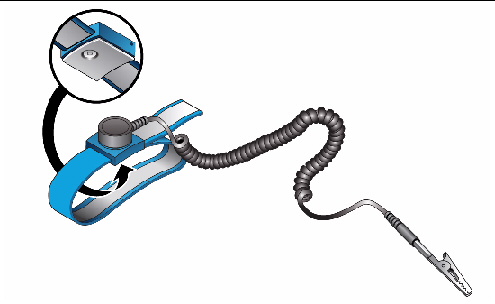
4. To mount a FRU, place it on the grounded antistatic conductive mat. With your bare hand wearing the antistatic wrist strap, touch the metallic FRU chassis for 5 or more seconds.
When touching the FRU, take care not to damage the parts such as the connector on the edge of the unit.

|
Caution - Do not touch the CMU, IOU, or the dummy unit without wearing an antistatic wrist strap. Failure to do so might result in serious damage to operating domains. |
a. Prior to mounting a new CMU or IOU, place it on the grounded antistatic conductive mat.
b. Touch the metallic chassis for 5 or more seconds with your bare hand wearing the antistatic wrist strap. (See FIGURE 2-2 or FIGURE 2-3)
You cannot remove static electricity by touching the label.
FIGURE 2-2 Metallic Chassis (CMU)
FIGURE 2-3 Metallic Chassis (IOU)
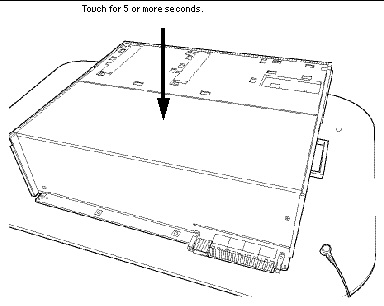
c. Touch each of the designated points on the guide blocks for 5 or more seconds with your bare hand wearing the antistatic wrist strap. (See FIGURE 2-4 or FIGURE 2-5)
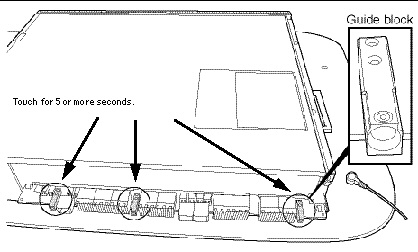
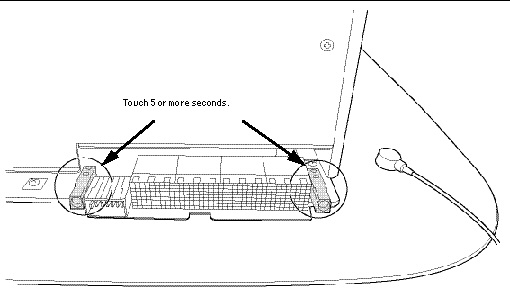
This section provides the information of the grounding port connection locations of the M8000/M9000 servers.
The grounding port can be used to connect the clip of the antistatic wrist strap and the antistatic conductive mat.
FIGURE 2-6 M8000 Grounding Port Connection Locations for the Wrist Strap Clip and the Antistatic Conductive Mat (Front View)
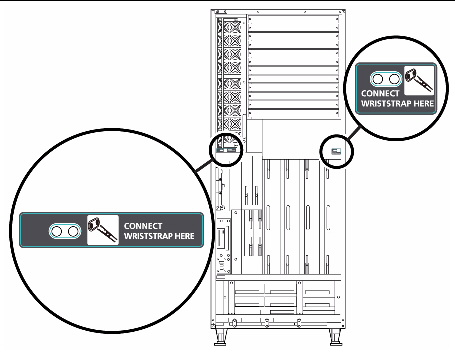
FIGURE 2-7 M8000 Grounding Port Connection Locations for the Wrist Strap Clip and the Antistatic Conductive Mat (Rear View)

FIGURE 2-8 M9000 Grounding Port Connection Locations for the Wrist Strap Clip and the Antistatic Conductive Mat (Front View)
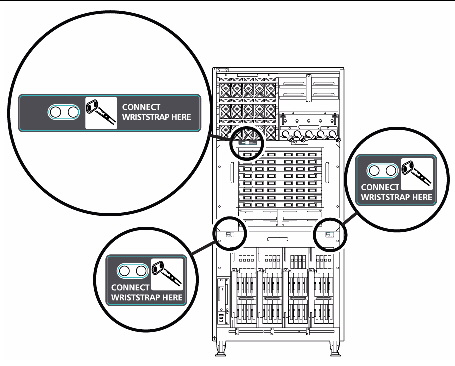
FIGURE 2-9 M9000 Grounding Port Connection Locations for the Wrist Strap Clip and the Antistatic Conductive Mat (Rear View)
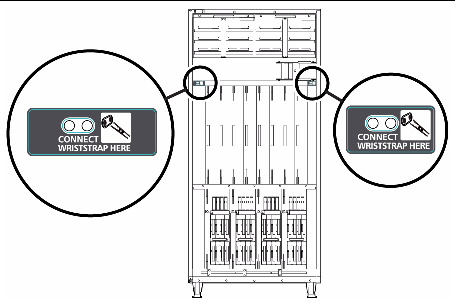
The table found in Section 1.2.1.2 of the Sun SPARC Enterprise M8000/M9000 Servers Site Planning Guide will be updated with the information in TABLE 2-3, below. The table lists the external dimensions and weights of the Sun SPARC Enterprise M8000/M9000 server cabinet.
|
700[3] |
||||
|
1880[4] |
||||
|
75[5] |
||||
|
350[6] |
||||
The Specifications (Cooling and Air-Conditioning Requirements) table found in Section 3.2.1 of the Sun SPARC Enterprise M8000/M9000 Servers Site Planning Guide will be updated with the information in TABLE 2-4, below. The table lists the cooling and air-conditioning requirements for each system component.
|
13968-37764 [7] |
|||||
|
SPARC Enterprise M9000 server (base cabinet + expansion cabinet) |
|||||
|
- [8] |
|||||
|
Power Cabinet (for SPARC Enterprise M9000 server base cabinet) |
|||||
|
Power Cabinet (for SPARC Enterprise M9000 server base cabinet + expansion cabinet) |
Section 3.3 of the Sun SPARC Enterprise M8000/M9000 Servers Site Planning Guide will be updated with the following tables.
The CPU Types and Power Specifications information found in Section 3.3.6 of the Sun SPARC Enterprise M8000/M9000 Servers Site Planning Guide will be updated with the information that appears below, including the following tables.
This section describes the CPU types and the maximum power consumption of the server. There are four types of CPU. The power specifications of the SPARC Enterprise M8000/M9000 servers vary depending on the CPU type and the system configurations.
The tables list the specifications of maximum power consumption, apparent power, and heat dissipation by the type of CPU. The figures represent the system configuration described below the table, in which every CPU/Memory Board Unit (CMU) is mounted with the same CPU.
Section 1.2.2 of the Sun SPARC Enterprise M8000/M9000 Servers Overview Guide will be updated with the information that appears below, including the following tables. The table shows samples of power consumption of specific configurations and program load. The power consumption of the system varies depending on configuration of the system, characteristics of your running programs and ambient temperature.
|
Configuration[15] |
||||
|
Power consumption[16] |
||||
Copyright © 2010, Oracle and/or its affiliates. All rights reserved.